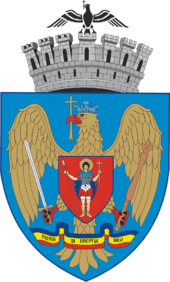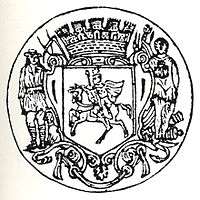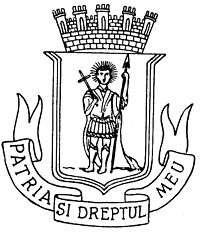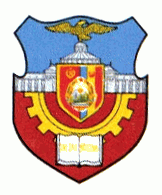Coat of arms of Bucharest
| Coat of arms of Bucharest | |
|---|---|
 | |
| Details | |
| Armiger |
|
| Adopted | 1994 |
| Crest | A seven tower mural crown with a black eagle atop of it |
| Escutcheon | on a field, Azure, an eagle, or, facing dexter, crowned, azure, a Latin cross in its beak, its dexter claw holding a sword, argent, sinister claw a sceptre, Tenné |
| Supporters | None |
| Motto | Romanian: Patria si Dreptul Meu ("The Homeland And My Right") |
| Other elements | inescutcheon: on a field, Gules, with thin bordure, azure, an image of St Dimitrie Basarabov, holding dexter a spear, sinister a Latin cross |
The coat of arms of Bucharest is the heraldic symbol of the capital city of Romania. The present-day coat of arms was adopted by Domnitor (Ruling Prince) Alexandru Ioan Cuza, and changed under the Communist regime. In 1994, it was renewed again with minor alterations.
Description
The coat of arms consists of an escutcheon, bleu celeste, charged with an eagle, or, facing dexter (similar to the historical region of Wallachia - see Coat of arms of Wallachia), crowned, bleu celeste, blazoned langued and armed, gules, with a Latin cross in its beak, standing over the motto PATRIA ŞI DREPTUL MEU ("The Homeland And My Right") on a scroll, tricoloured horizontally red-yellow-blue (colours of the Romanian national flag).
The eagle holds in its dexter claw a sword, in its sinister a sceptre, Tenné, and on its breast an escutcheon, gules, with thin bordure, azure, charged with the image of Saint Dimitrie Basarabov holding, dexter, a spear and, sinister, a Latin cross.[1] The saint, who is the city's patron, is commonly referred to as simply Saint Dimitrie (Demetrius),[1] thus bearing the same name as the 4th century Saint Demetrius of Thessaloniki—today's arms seem to represent the latter, as the person depicted is dressed in a Roman uniform.[2]
The crest consists of a seven-towered mural crown, argent, over which stands a stylised eagle, sable, with wings displayed, facing dexter, with a Latin cross in its beak.
History


An early heraldic symbol for Bucharest was first used on seals of the town's judet (mayor) and pârgari (town council) as early as the 16th century: it usually featured images of the Madonna and Child or the Annunciation, and was accompanied by an inscription in either Church Slavonic or Romanian, which were simply variations of the phrase "this is the seal of Bucharest".[3]
Under the Organic Statute rule of Pavel Kiselyov, the city was awarded the new symbol of a standing woman wearing a shoulder sash and carrying the Scales of Justice (in 1862, the woman was seated, carrying both the scales and, in her left hand, flowers and ears of wheat).[3]
According to Constantin C. Giurescu, Alexandru Ioan Cuza changed the seal to depict the patron saint and an image of the mythical shepherd Bucur.[3] However, it appears that St Dimitrie Basarabov (or St Demetrius) was introduced as a symbol during Cuza's reign (in 1864, as attested by Monitorul Oficial).[2] The arms were enlarged after World War I, when the mural crown and all other present-day elements were added, while the image of Bucur was removed.[3]

No symbol was in use between 1948 and Nicolae Ceauşescu's reforms of 1970. Then a new coat of arms was adopted, which lasted until the Romanian Revolution of 1989; it represented "the most characteristic elements of historical traditions and of political, economic and social relations".[4]
The 1970 coat of arms consisted of an escutcheon divided party per fess; chief, landscaped, an eagle, or, wings displayed, facing sinister, over the image of the Palace of the Patriarchate, argent, on an azure field; over a cogwheel, or, with an open book with the lettered motto CIVITAS (verso) and NOSTRA (recto) (reading "Civitas Nostra" (Latin for "Our City"), or, on a field, gules; with an inescutcheon divided party per pale, dexter a hammer and sickle (symbol of the Romanian Communist Party)) on a field, gules, sinister the flag of Romania, the inescutcheon charged with the crest of Communist Romania.[5]
See also
| Wikimedia Commons has media related to Coats of arms of Bucharest. |
Notes
References
- (Romanian) Decree nr. 503 16/12/70 regarding the establishment of county and municipality seals, at the Chamber of Deputies of Romania site, retrieved July 4, 2007
- Mic Dicţionar Enciclopedic, Editura Ştiinţifică şi Enciclopedică, 1978
- Constantin C. Giurescu, Istoria Bucureştilor. Din cele mai vechi timpuri pînă în zilele noastre, Editura Pentru Literatură, Bucharest, 1966
- (Romanian) Gheorghe Vasilescu, Sfântul Cuvios Dimitrie, ocrotitorul spiritual al Bucureştiului, at the Romanian Patriarchy Site, retrieved July 4, 2007
